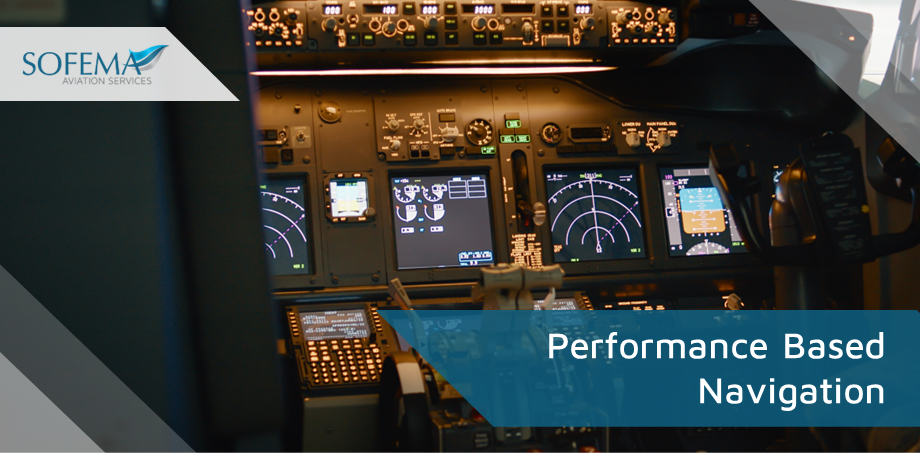Sofema Aviation Services (SAS) – reviews the current status of Performance Based Navigation (PBN) from an FAA perspective.
See here for reference.
Introduction – Performance Based Navigation
PBN offers the potential for environmental benefits through improved fuel usage, reducing C02 emissions, and eliminating high-thrust go-arounds.
- The degree of impact on requirements for crews, flight operations, maintenance, and dispatch could range from minimal to significant, depending on the current state of airports serviced and associated operating requirements.
- Flying down the middle of a defined flight path means less throttle activity and better avoidance of noise-sensitive areas, so people on the ground perceive less jet noise and are exposed to fewer engine emissions.
The FAA defines “Performance Based Navigation” PBN as “a framework for defining navigation performance requirements that can be applied to an air traffic route, instrument procedure, or defined airspace.”
- PBN, typically comprises both RNAV and RNP specifications, provides a basis for the design and implementation of automated flight paths that will facilitate airspace design, traffic flow, and improved access to runways.
Definition – RNAV
Area navigation (RNAV) is a method of navigation that permits aircraft operation on any desired flight path within the coverage of ground- or space-based navigation aids, or within the limits of the capability of self-contained aids, or a combination of these.
Definition – RNP
Required Navigation Performance (RNP) is similar to Area Navigation (RNAV); but, RNP requires on-board navigation performance monitoring and alerting capability to ensure that the aircraft stays within a specific containment area.
Introducing Performance Based Navigation PBN
The PBN concept began with an assessment of all current and near-term implementations of RN AV and RNP, including basic RNAV (BRNAV) standards, precision RN AV (PRN AV), RN AV 1, RNAV 2, RNP < 1, RNP 1, RNP 2, RNP 4, and RNP 10
- Part of the goal of PBN is to consolidate these various implementations to remove confusion and streamline operations.
- RNAV now includes BRNAV, PRNAV, RNAV 1, RNAV 2 and RNP 10 (now RNAV 10), and RNP now includes RNP < 1, RNP 1, RNP 2, and RNP 4.
- This consolidation provides better guidance on how to apply RNAV and RNP and what it means to airspace, traffic management, air traffic control, and the commercial air service infrastructure.
- Because RNAV and RNP are part of PBN, lateral navigation standards for performance, functionality, and capability are intrinsic to it.
- PBN has the potential to provide operators with more efficient airspace and instrument procedures that can improve safety, access, capacity, and efficiency, while minimizing environmental impacts
- With PBN, all navigation aspects of operations — including terminal airspace — will be defined, developed, and implemented on the basis of operational requirements and the associated required performance.
Benefits of Performance Based Navigation PBN
Benefits include:
- Safety: Lateral and vertical track-keeping is much more accurate and reliable due to new three-dimensional guided arrival, approach, and departure procedures that cannot be defined by conventional navaids.
- No accidents have been reported to date associated with the use of RNP/ RNAV procedures. In contrast, for all controlled flight- into-terrain accidents, 60 percent occur on non-precision approaches using conventional navaids.
- PBN also reduces the flight crew’s exposure to operational errors
- Capacity: Delays, congestion, and choke points at airports and in crowded airspace may be reduced because of new and parallel offset routes through terminal airspace.
- Additional ingress/ egress points around busy terminal areas, more closely spaced procedures for better use of airspace, and reduced or eliminated conflict in adjacent airport flows
- Efficiency: Enhanced reliability, repeatability, and predictability of operations lead to increased air traffic throughput and smoother traffic flow.
- Access: Obstacle clearance and environmental constraints can be better accommodated by applying optimized PBN tracks.
Performance Based Navigation PBN – The Future
PBN is enabling a future which enables a number of operational changes, including
- Additional point to-point routes,
- Independent parallel runway operations, and
- Coordinated departures and arrivals for adjacent airports.
- When planning additions or modifications to a fleet, operators should carefully consider including RNP-related features such as navigation performance scales, a display feature that integrates lateral navigation and vertical navigation with actual navigation performance and RNP.
- Operators should also
o Provide as much information as possible about PBN to their operations departments and crews,
o Develop training curriculum and scenarios, and
o Review standard crew procedures.
o Operators should fully understand the capabilities of each airplane and match present and future capabilities to what they hope to achieve with PBN operations.
Next Steps
Follow this link to our Library to find & Download related documents for Free.
Sofema Aviation Services and Sofema Online offer Classroom, Webinar and Online Regulatory & Vocational Training. For additional details, please see www.sassofia.com and www.sofemaonline.com or email team@sassofia.com
Tags:
aviation, FAA, Introducing Performance-Based Navigation (PBN), PBN, Performance Based Navigation, Performance-Based Navigation (PBN), Required Navigation Performance (RNP), RNAV, SAS blogs, Sofema Aviation Services




